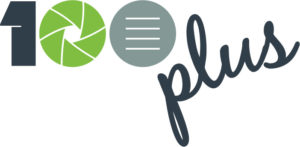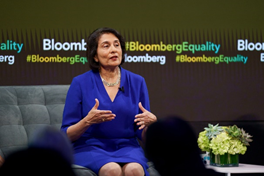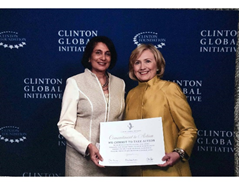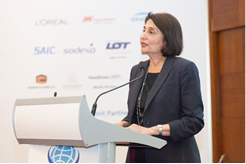Social justice is top of mind for organizations of all shapes and sizes from civil engineering firms to energy companies, tech and heavy manufacturing. With heightened awareness around systemic racism, many organizations are at an inflection point to do better, to be better. Outwardly, this has resulted in companies scrambling to publicly demonstrate a commitment to Diversity, Equity and Inclusion (DEI) in the workplace.
We interviewed Rohini Anand, former SVP and global chief diversity officer for Sodexo Group turned DEI consultant.
Rohini shared her thoughts on DEI and how to ensure workplaces are moving toward becoming more equitable and inclusive.

Dr. Rohini Anand was the SVP Corporate Responsibility and global chief diversity officer for Sodexo, which provides facilities management and food services to schools, universities, hospitals, senior living communities, venues, and other vital industries. It is the 19th largest employer globally with 460,000 employees – including many engineers – and $22.2 billion in annual revenue. The engineering career paths at Sodexo are diverse and include mechanical engineers, electrical engineers, facilities and maintenance engineers, and biomedical engineers. In her current role, Dr. Rohini Anand is a senior consultant and advisor on diversity, equity and inclusion with hundreds of global companies, government agencies, and non-profit organizations.
Could you share a little about your background? How did you find your way into being a DEI expert? What was this journey like?
The work I do around diversity equity & inclusion (DEI) is essential. For me, this work is very personal. I often say that my vocation and avocation are aligned. I grew up in India and came to the United States to go to graduate school. This journey was an inflection point that made me who I am today. Growing up in India, people looked like me, and I was part of the majority. When I came to the U.S., I was perceived as a minority and came with the recognition of what it means to be part of a majority and the privileges that come with it. This was critical in my personal journey.
I earned my Ph.D. from the University of Michigan. My research was based on personal experience, and I knew that I wanted to do something more practical with real-life impact. I moved into consulting on multi-cultural issues. This brought alignment between who I was and the work I was doing.
I wanted to engage with one organization to see the long-term culture change and have an impact. In 2002 I joined Sodexo. They were in the middle of a class-action lawsuit regarding promotion discrimination. I was hired to make the culture more inclusive and equitable. The leaders of the organization started to see the benefit of what we were doing with the business, employees, culture, and that is what you need companies to internalize. The investment in DEI became part of the DNA of the organization and senior leaders.
I don’t see myself as an expert but a work in progress on DEI. By its very nature, DEI is complex and messy and continually evolving, and as such, I see myself on this continual learning path.

Photo courtesy of Rohini Anand.
DEI is a well-established practice in some businesses, and others are just now coming to understand what it means. How do you explain DEI to people who are struggling to grasp what it means in, and for, business and industry?
The simplest way I can describe this is that diversity is a fact – it is a given and what makes us unique. It is the mix.
Equity is creating a level playing field. Ensuring you have initiatives to create a level playing field for everyone to succeed and contribute fully to the organization’s outcomes.
Inclusion is making the mix work, and that is a choice. A choice to create a culture where everyone can succeed and belong. Just having the mix is not enough; you also have to have an environment that embraces the mix and allows the combination to work toward the outcomes of the business.
Diversity + equity = inclusion
Where do you advise companies to start? DEI can feel like a big undertaking. How should companies approach this?
First, you need to identify what problem you are solving. Why are you engaging in this effort? What are the gaps that need to be addressed? Addressing a culture change or transformation is something meant to enhance the business outcome. You need to identify levels of the organization that require more representation. Are these customers, users, leadership? Then, look at your assessment of data, metrics, engagement scores and understand what is going on. Where are the barriers, and how do you address those barriers?
Why is having a diverse workforce important?
Having a diverse workforce is essential for several reasons. First, because it is the right thing to do; it is about social justice. DEI is a strategic platform for business strategy, and you need to have ample resources dedicated, set measurable targets and accountability at senior levels. To get there, you have to take a circuitous path. Organizations want to understand how this will benefit their business. Questions to ask yourself are:
- Talent: All organizations are competing for the best engineering talent. If you consistently hire the same talent, you reach a point of diminishing returns. You need to broaden the base. You need to hire a diverse mix with different backgrounds and life experiences to bring new innovative approaches.
- Innovation: Just having diversity in the workplace is not enough. You must ensure that you create an environment where everyone can contribute ideas – and enable an environment where people can work together to generate more creative solutions. Diversity leads to innovation, but the optimal mix is more innovative, more creative, more productive, and better financial return.
- Customer satisfaction: Are we meeting the needs of our diverse customer or client base? Do we clearly understand their needs and provide culturally appropriate outcomes?
- Business equity: There is a lot of research to show that diversity within organizations and at senior levels leads to higher shareholder value. This is the return on equity.
What does it mean to be an inclusive leader?
An inclusive leader has a mindset that embraces DEI, behaviors that demonstrate the commitment and actions and bring it to fruition. Inclusive leaders have a perspective that understands cultural nuances and the humility to learn and be open to learning, the ability to be empathetic, and bridge differences. The behaviors demonstrate the ability to put themselves in the other person’s shoes, understand the perspective and build relationships across differences. And finally, the actions bring it to fruition by having the courage as a leader to take a stand on issues and do the right thing.

Photo courtesy of Rohini Anand.
What should DEI look like internally & externally when done correctly? Are there any companies doing it well that you can point to as a leader in DEI?
When DEI is done right, it is integrated into all systems of the organization. DEI is not a bolt-on. It is about how work is done within marketing, finance, strategy, the talent lifecycle – recruiting, development, promotion, succession planning. DEI is not a stand-alone initiative, or simply check–the–box activity or even a series of initiatives. It needs to be embedded in all systems and processes, internal and external. Today, there is a proliferation of external stakeholders that must be considered. Many companies are doing DEI well, especially in the consumer marketing space – Procter & Gamble and Unilever are examples of companies doing DEI in s strategic way and making a difference internally and in the community.
Do you think engineering companies should identify one person to be the lead DEI spokesperson? How do you determine who this person should be?
There is no one solution, and this kind of work is iterative; it needs to respond internally and externally to the evolving landscape. There should be a point person to galvanize the organization, but it does not fall at one person’s feet. Teams need to work across advocates and champions – many people across the organization are working towards these objectives. The executive team has accountability at the top, including leadership groups and boards – it cannot just be the CEO. You do need to have someone shepherd the process, however.

Photo courtesy of Rohini Anand.
Some companies might be asking, “How do we get more diversity in our organization?” What advice do you have for them?
Diversity, equity, and inclusion is a long-game, and you need to start with recruiting the right talent. Begin by mentoring women and people of color, exposing them to careers or internships within your organization. Stay invested and keep in touch; it takes time & effort.
You will find a lot of competition for the same talent, and good talent has choices. This means you need to figure out how you want to brand yourself – beyond money & benefits. It is about culture now. They can go to any elite engineering organization, but they choose YOU because of diversity and the company culture. New recruits want to see women and people of color in senior leadership roles. This speaks to their own career possibilities.
Gen Y and Gen Z millennials are purpose-driven. This means culture is more important to them, and they are willing to walk away if they don’t see organizations being purpose-driven. From a talent perspective, what your culture says about your organization as a brand is critical.
Once you get the talent within the organization, your job is now about how to keep them. You will want to offer to make sure you are intentional about retaining and developing this talent. This is where mentoring, sponsorship, high-profile assignments, clear career progression comes in.
For our readers that are looking for additional DEI resources or to connect with you directly, what is the best way to reach you?
You can find me on LinkedIn or at my website: https://www.rohinianand.com. I also have a book coming out titled “Leading global diversity equity & inclusion, a guide for systemic change in multinational organizations” which will be available in bookstores this fall.
– Emily Pappas, The Engineering 100
